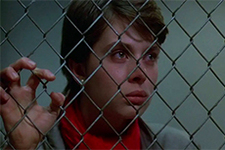Cat People [Blu-Ray]
|

When producer Val Lewton and director Jacques Tourneur made Cat People for RKO in 1942, it was, for that time, a genuine rarity: a serious horror film. The American horror genre, having peaked in the 1930s with classics like Tod Browning's Dracula (1931) and James Whale's Bride of Frankenstein (1935), not to mention having suffered a long string of protests and censorship, was moving toward parody by the 1940s. However, Tourneur and Lewton crafted in the low-budget Cat People an eerie and evocative story of female sexuality as lethal threat, generating chills while leaving virtually everything off-screen. When Paul Schrader remade Cat People exactly 40 years later in 1982, it was again notable for being a genuinely serious horror movie in the midst of increasingly parodic horror movies, intentional (1981's An American Werewolf in London) and otherwise (one might think of how the slasher movie had all but taken over the genre by that point). Schrader, a deeply serious filmmaker best known for having penned Martin Scorsese's Taxi Driver (1976) and written and directed a triptych of explorations of modern American society and sin (1977's Blue Collar, 1978's Hardcore, and 1980's American Gigolo), approached the Cat People remake with nothing less than the mythic in mind. Using a script by make-up effects artist-turned-screenwriter Alan Ormsby (Deathdream, My Bodyguard), he took the basic concept from the original film and attempted to turn it into a colorfully erotic bit of horror-fantasy, eschewing the original's subtlety for graphic violence, full-frontal nudity, and a New Wave electronic score by German rocker-composer Giorgio Moroder. This is, of course, dangerous territory to wade into, considering that the most recent attempt by a notable director to craft a new horror-myth was John Boorman's Exorcist II: The Heretic (1977), an ambitious but supremely silly flop. Luckily, Schrader kept better control over the potential silliness of his material, delivering a film that stayed true to his literary vision of myth in the modern world while also delivering moments of graphic gore and the kind of transformative special effects audiences were coming to expect. Schrader's film was part of a concerted effort by Universal, the studio that produced it, to lean heavily on science fiction, horror, and fantasy; 1982, the year in which Cat People was released, also saw the studio putting out Conan the Barbarian, E.T. The Extra-Terrestrial, The Thing (another remake of a classical-era horror film), Videodrome, and The Dark Crystal. The early 1980s were also witness to numerous horror films involving human-to-animal transformation—the aforementioned An American Werewolf in London, The Howling (1981), and Wolfen (1981). Thus, although Cat People seems like an odd experiment in mixing horror, fantasy, and erotica, it was very much in line with a number of trends at the time, including (unfortunately) a string of big-budget failures by fellow New American Cinema auteurs (Martin Scorsese's New York, New York had bombed in 1977, as had Robert Altman's Popeye in 1980 and Francis Ford Coppola's One From the Heart in 1981, which also featured Cat People star Nastassja Kinski). Like the original, Cat People is about a race of humans who turn into black leopards when sexually aroused. The myth-story behind this race was completely rewritten for the remake, however, informing us that, in some prehistoric age, humans used to offer up their adolescent women to leopards who mated with them and produced the new race of cat people. This is told to us in the ravishing, red-hued opening setpiece, designed by visual consultant Ferdinando Scarfiotti, who designed many of Bernardo Bertolucci's films and had previously worked with Shrader on American Gigolo. The opening is deliberately theatrical, creating a lyrical, otherworldly atmosphere that recalls the in-camera special effects of classic cinema (Francis Ford Coppola would achieve a similar look throughout his gaudy 1992 horror film Bram Stoker's Dracula). The main character is Irena Gallier (Nastassja Kinski), who has not yet turned into a cat and is not fully aware that it is her destiny in life to do so. Rather, she is a reserved young woman on the verge of sexuality (that is, she is still a virgin, although Kinski is so sensual throughout the film that it is hard to believe in her sexual inexperience). When the film opens, Irena, an orphan all her life, has just been reunited with her older brother, Paul (Malcolm McDowell), in his home in New Orleans. She ends up falling in love with the curator of the New Orleans Zoo, Oliver Yates (John Heard), a man who admits to liking animals more than people, which explains why he becomes so obsessed with Irena and her animal within (otherwise, their romance is pretty flat, as Heard and Kinski have little chemistry). Of course, because Irena's inner cat emerges when she is sexually aroused, Oliver is in great danger if he wants to make love to her (we know exactly what might be in store for him since we get to see what Paul has done to some of his victims). In a perverse twist on the original's concept of sexuality as animalism, Schrader's Cat People suggests that Irena and Paul are the only two cat people left. Thus, if they want to have sex, it has to be with each other, otherwise they devour their mates (when Irena declares that she is not like him, Paul replies coldly, "That is the lie that will kill your lover"). This leaves Irena torn between two choices: safe, but incestuous sex with her brother, or dangerous sex with the man she loves. Despite its many flaws, Cat People is nothing if not interesting, and it has several sequences that are genuinely electrifying and audacious, particularly a horrifically gory moment in which an assistant zookeeper played by Ed Begley Jr. gets his arm ripped out of its socket by Paul as a leopard. Unfortunately, those sequences are scattershot, as Schrader tells the story in awkward chunks, often making rough transitions that don't entirely make sense. A good example is a scene near the end of the film in which Irena stalks Oliver's ex-girlfriend, a friendly coworker named Alice (Annette O'Toole), in a swimming pool. The scene is a direct quotation from the most effectively creepy scene in the 1942 original, but here it makes no sense because Irena's gleefully threatening personality matches neither her personality traits before the scene or what follows and she lacks the sense of jealousy that drove Irena in the original. Another ludicrous quotation from the 1942 film involves a woman "recognizing" Irena as a cat person and calling her "mi hermana" ("my sister"). In the original, this worked because it suggested an entire underground network of cat people slinking around the world, whereas here it completely undermines the necessity of incestuous sex since it suggests that Irena and Paul are not the last of their kind (unless, of course, we want to read Paul as being so perverse that he just wants to have sex with his sister). Some have the read Cat People as being blatantly misogynistic, particularly in the way it subdues the threatening aspects of Irena's sexuality and asserts absolute male control at the end. From a certain perspective, this is an entirely valid reading, especially when compared to the sexual ideology at work in the original. Schrader insists on reading the film as an allusion to Dante and Beatrice—with Oliver's Dante pursuing the unattainable Irena's Beatrice—and while such an understanding of the material turns the ending into a moment of tragic enshrinement, it is hard to get away from the fact that Irena's final shrine is literally a cage.
Copyright © 2020 James Kendrick Thoughts? E-mail James Kendrick All images copyright © Shout! Factory | |||||||||||||||||||||||||||||
Overall Rating:



 (3.5)
(3.5)
Subscribe and Follow
Get a daily dose of Africa Leader news through our daily email, its complimentary and keeps you fully up to date with world and business news as well.
News RELEASES
Publish news of your business, community or sports group, personnel appointments, major event and more by submitting a news release to Africa Leader.
More Information
